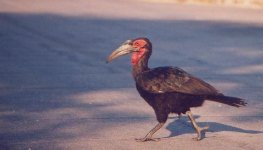Marysan,
Nice site & pics. I may be able to help with your 'unknown' ducks. I think the first one (facing right) is an immature female Red-crested Pochard - the head and body colouration seem to fit, all that's 'odd' is the bill, which I think may be age-related, as with some duck species the bill changes colour to indicate readiness for breeding.
Number two seems to me to be an adult male Maned Duck (from Australia) - did you see it stretch its wings, and if so were there white panels on the secondaries ?
The goose appears to be an adult Ashy-headed Goose, from southern South America - from the illustrations I have, both sexes appear similar.
These tentative IDs are purely from looking at illustrations, so I may not be correct - perhaps one of our members from the relevant countries can check the pix out and confirm or deny ?
Tony
Just noticed there's another unknown duck, between the Pelicans and the White-faced Whistling Duck - that one, I think, is an adult male Cape Shelduck, from Southern Africa. Again, usual caveats apply.




